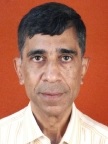Colloquium # 293
Structural and Dynamical Transition in Functional Materials
By Prof Ramaprosad Mukhopadhyay
Raja Ramanna Fellow, DAE, Govt. of India.
Ex-Head, Solid State Physics Division, BARC
Friday, Nov 2nd 2018 at 3:30 PM
Seminar Hall

Abstract
Phase transition in condensed matter is an interesting phenomenon from both experimental and theoretical point of view. It can occur either on application of temperature, pressure or field. There exists variety of nomenclature to delineate various kinds of transitional behavior, particularly regarding order of a transition etc. Phase transition has been studied by using macroscopic and microscopic probes. Dynamical transition, viz, order-disorder, sublattice melting, etc. is related to motion of atoms and molecules, leads to many applications. In this context, diffusion or reorientation of a molecular species is of interest in various functional materials. Diffusion is actually a stochastic process. Such a process over a time scale ca 10-10 – 10-13 sec is conveniently studied using neutron scattering technique. It is particularly suited for studying the dynamics in hydrogenous materials (viz. organic, polymer, soft matter and biological systems etc.) as hydrogen has large scattering cross section. It offers unique possibility of analyzing spatial dimensions of atomic or molecular processes in their development over time. The time-scale of the dynamical motion, its geometry as well as the nature of the hindering potential can be obtained from the neutron scattering data. Molecular dynamics simulation studies are very useful for further insight in the underlying processes as it does not suffer limitations of an experimental setup. We have studied various systems, for examples, atomic or molecular diffusion (translation and rotation) in crystalline systems, confinement of molecules in nano pores, like clay, zeolites, molecular sieves, metal organic framework etc; polymer based membranes, molecular magnets; nano-metal clusters; micelles, vesicles/lipid (a model biological systems) etc. Some of the recent results as obtained from neutron scattering experiments and molecular dynamics (MD) simulation will be discussed.
About the speaker
Prof Ramaprosad Mukhopadhyay, Former Head, Solid State Physics Division, BARC and Ex-Outstanding Scientist, is a Raja Ramanna Fellow at present. He joined the neutron scattering group of the Solid State Physics Division of Bhabha Atomic Research Centre (BARC) as Scientific Officer in 1980 after completion of M.Sc in Physics. Since then he is engaged is working on neutron scattering in condensed matter, and specialised in stochastic dynamics using neutron scattering. He was one of the main associates from BARC for the international collaboration with Rutherford Appleton Laboratory, UK during 1993-1998 and Institute Laue Langevin, Grenoble, France, during 2011-2015. His research interest includes, Phase Transitions, Stochastic dynamics in Condensed Matter, Transport, Dynamics in Soft Matter and model Biological Systems, etc. He worked as visiting scientist at ISIS facility, Rutherford Appleton laboratory (1990-91), visiting professor at Depto de fisica de Materiales, Universidad, del Pais Vasco, San Sebastian, Spain (1996-97) and Visiting Scientist at KENS, KEK, Japan (2000). He is the recipient of MRSI Medal (2012) and DAE group achievement award (2009 and 2015). He is a senior professor at the Homi Bhabha National Institute, Mumbai, India.

